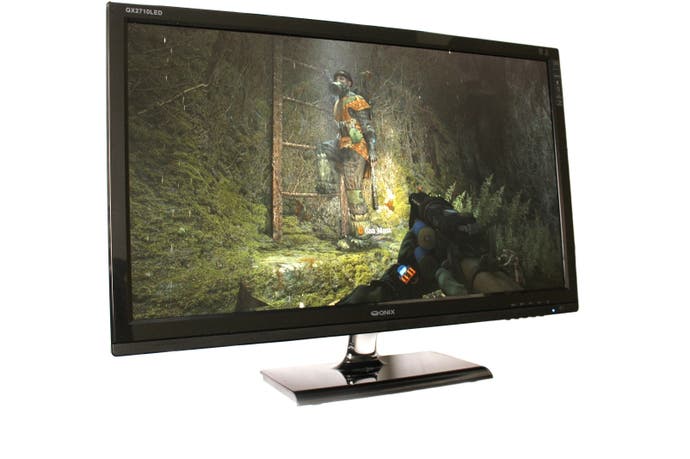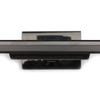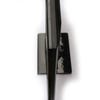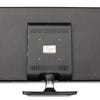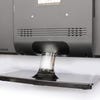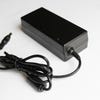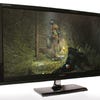Digital Foundry vs. the 2.5K display revolution
Take PC gaming beyond 1080p with a new generation of ultra-res monitors that cost just ?275.
With the arrival of Xbox One and PlayStation 4, at last console players are set to enjoy a raft of cutting-edge games taking advantage of the pixel-rich "Full HD" standard. However, with 1080p so established, it's perhaps no surprise that the PC faithful are already itching to leap-frog to an improved level of fidelity. With 60Hz 4K displays currently starting at an eye-watering $3,500, it's the 2560x1440 standard - also known as "2.5K" - that is swiftly gathering pace, providing a boost to resolution that almost certainly won't be matched by the upcoming crop of consoles. We've made the upgrade ourselves and the experience represents a tangible, highly desirable leap over 1080p - and best of all, the total cost for the display upgrade was just £275.
A quick look at Google's price comparison engine suggests that our eBay investment in the Qnix QX271LED Evolution II represents excellent value for money. At a glance, we have similar 27-inch offerings such as Asus' PB278Q available for £475, while Dell's Ultrasharp U2713HM costs around £415 - both offering the same 2560x1440 resolution as our chosen purchase. However, these come bundled with many superfluous features, components and additional ports that while nice to have, aren't necessarily required if high-resolution PC gaming is the only objective.
Starting around two years ago, South Korean brands like Yamakasi and Crossover made a name for themselves on eBay by providing high quality 2.5K IPS panels - the same technology used in Apple and Dell's 27-inch models - starting at around the £250 mark. Concessions to keep the price on the low side for the "entry level" models include the stripping down of inputs to just a single DVI-D port, a lack of on-screen display (OSD) controls, and the removal of any built-in scaler to handle lower resolutions. It means this is truly a monitor for one task: PC gaming at 2560x1440, and one which it achieves with aplomb.
Now there is a competing technology to the established IPS standard: two brands named Qnix and X-Star have approached the market, savagely cutting prices for Samsung's latest PLS panel technology - considered a more energy efficient, brighter evolution of IPS. With Qnix's QX271LED Evolution II doing the rounds on eBay, it re-appropriates unused panels from the big companies to achieve sterling results for a relative pittance. We took the plunge for £275 including shipping and customs duties to see what the fuss was about, and if a sneaky in-road to 2.5K gaming on PC is possible on the cheap - and what the drawbacks may be by importing a Korean screen.
Build quality: first impressions
Unboxing the unit, we're delivered a better-built beast than the price would lead us to expect, with a black brushed aluminium strip at the bottom leading to a blue LED power light on the far right. The glossy bezel on front is a sure-fire fingerprint magnet, while fully textured matte plastics are used to shield the rear of the panel. There are no creaks to the touch, and it feels sturdy as a whole. On its underside are just five circular buttons to control rudimentary settings: two for raising and lowering brightness, two to adjust speaker volume, and the last for power. There's a larger button on the front, but this has no function assigned to it, so this perhaps used in more expensive models with OSD controls and HDMI inputs.
The rectangular stand, too, is a matching black with a glossy coat. Assembly is straightforward, with the monitor slotting into an oval recess and locking in with a supplied metal key. When moved about this has a slight wobble to it, but on a sturdy desk it sits completely stationary. It's also quite limited in terms of adjustments, providing a very strict range of tilting positions that takes some force before it juts forward - and often further than intended. Even so, it's enough to satisfy most users once properly set, while the VESA mount measuring at 100x100mm on the back offers an alternative - though strangely there's no convenient way to remove the stem leading from the back of the monitor. All necessary cables are supplied in the box, including one DVI-D lead, and a small 12v step-down converter into which any standard kettle lead is plugged.
True to its promise, connectivity is limited to just a DVI-D input, a 3.5mm input for sound, and another slot for DC power. Curiously, two 5w speakers are integrated into the rear of the monitor, and though the output is expectedly muffled and lacking in bass presence, it's a welcome bonus to the set-up regardless. Given that crucial features such as OSD controls and a scaler chip are eschewed in favour of the lower price point, it's surprising that this hasn't been cut from the feature-list as well to save a few pennies, but as a last resort this is handy for YouTube viewing, and doesn't bloat the width of the front bezel. Overall, it's a simple, clean, effective design, stripped down to the essentials without appearing too much like a budget solution.
Screen quality put to the test
Powering the screen on, it's hard not to be taken back by quality of the display. Colour reproduction is superb, brightness ramps up very high indeed, and it boasts a standard 72 per cent NTSC gamut with no visible banding on colour gradients. The coating over the top finds a pleasing middle-ground between matte and glossy too, preventing the screen from appearing mirror-like whilst still being smooth enough to let light diffuse from the panel evenly, avoiding the speckled, grainy appearance of some other anti-glare coats. Coming from a 24-inch 1080p screen, the boost in sharpness for this 27-inch panel is also immediately felt, giving us an overall PPI of 108. The listed 178 degree viewing angle also means we don't experience a dimming effect to the top and bottom of the screen when our line of sight is central, as is a problem with cheaper twisted nematic (TN) panels at this size.




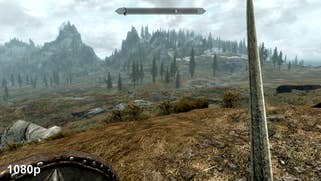
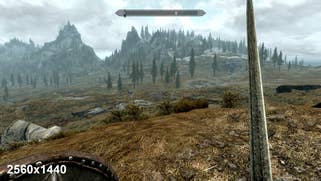
Are there drawbacks? Yes, and they're all unique to our display, just as every monitor brings its own characteristic issues. We ordered a "perfect pixel" model, and as promised there isn't a single hot or dead pixel to our eye, but there is a speck of dust to the bottom-left which keeps it from perfection. The second issue is that of backlight uniformity: being edge lit by LEDs means the risks are greater, and here we're at the mercy of a single leak to the right of the Qnix label at the monitor's centre - though this pocket of light only becomes visible in dark rooms. Otherwise, colour and light uniformity is perfect across the rest of the monitor, and these two defects are difficult to catch in operation.
The third issue is solved with the relevant know-how: our Qnix monitor arrives with a yellow tint at its factory settings, sticking out like a sore thumb next to properly calibrated displays. Usually this would be a quick fix via a monitor's OSD controls, but since there are only two buttons to modulate brightness, these colour tweaks must be made through a professional colorimeter, or alternatively by fiddling with the GPU control panel's colour settings.
The QX271LED is very aptly positioned for gaming, as long as it's just with a PC. As a knock-on effect of removing all extra connections, hardware scalers and OSD menus, the monitor's input lag averages at under 10ms, giving us less than a frame in delay between a keyboard input and its response. Even in comparison to the blazing sub-1ms response of Dell's U2312HM, it's still extremely reponsive, unusually fast for any LCD. Playing shooters like Planetside 2 provides us with a surprising feeling of sharpness with every mouse movement.
However, in visually rich titles like Crysis 3 we find the pixel response on repeat high-contrast details, such as meshed gates or clusters of tree leaves, causes a light flickering and moire noise that can't be ignored. Certainly, additional image processing would help to pinpoint these visually busy spots, though the raw delivery of the image helps to keep input lag low. Regardless, the overall picture quality elsewhere is astounding for a monitor of this price bracket, and the resolution upgrade to 2.5K is immediately felt when looking across Skyrim's distant landscapes with object and detail fade settings at max. That is, if this kind of luxury can be afforded by your GPU.
The performance reality of 2.5k gaming
A decent 2.5k monitor is evidently within reach for a reasonable price, but the expenditure really doesn't end there. Since 2560x1440 represents a 77 per cent increase in pixel count over 1080p, we must ask ourselves: how deep do we need to dig into our pockets to afford the bare minimum GPU upgrade to drive such an advanced visual experience? In our earlier review, we found that a middle-ground Kepler GPU like the GTX 760 is well suited for playing Crysis 3 or Metro Last Light at something approaching 1080p60, but forcing it to pump out higher resolutions proves somewhat more challenging.
Alternative comparisons:
- Crysis 3 High Settings: Nvidia GeForce GTX 770 - 1080p vs. 2560x1440
- Crysis 3 Very High Settings: Nvidia GeForce GTX Titan vs. GeForce GTX 780
The drop to 40 frames-per-second on the GTX 760 is a sobering one, and forces us to consider several workarounds. The first and most obvious trick is to lock gameplay to an easily-achieved 30fps baseline, while the second option involves buckling on the visual front and dropping cost-heavy post-processing effects in the settings menu. It's a similar story for AMD's equivalent Radeon HD 7950, currently costing £225, which already struggles to hold 60fps at 1080p as consistently at high settings in Crysis 3, and suffers from a likewise drop to 40fps with the resolution bump.
In either case, the GTX 760 and HD 7950 can be considered the lowest-priced point of entry to 2.5K gaming, with their 256-bit memory buses allowing fill-rates to comfortably support the high throughput. Certainly, less capable graphics cards with similar memory bandwidths can stretch to such a resolution, but at the cost of dropping the visual settings to medium or lower to support it. The inevitable off-shoot of such a visual downgrade is that the loss in asset and effects detail could become more noticeable at 2560x1440, though there is clearly a law of diminishing visuals returns on the very highest quality settings on most PC games. There's always a trade-off between quality settings and frame-rate - it's just that at the 2.5K level, the choice becomes emore pronounced.
Accepting that £200 is the minimum buy-in for a 2.5K compatible GPU, what kind of money might we need to pay for a premium take on the experience? Playing at 2.5K with maximum settings in Metro: Last Light gives even pricier cards like the GTX 770 a run for its money, stuttering as it does with 35FPS average in town-hub areas like Bolshoi. However, sticking to medium settings converts to a perceptibly smooth 60fps experience with this card - the same being true of Crysis 3 at just high settings, which lurks in the 50-60 range. Moving up a peg on the resolution scale invariably means that something has to give - but based on our testing, we'd definitely take resolution and frame-rate over the iterative improvements to visual effects that make up the majority of the top-end quality presets on PC games.
At this point, it's worth pointing out that Crysis and the Metro titles are games that tax graphics hardware in a highly uncommon manner - they're our "go to" titles for pushing GPU tech to the limit. The vast majority of AAA titles run much more smoothly, as you'll see in the next video, which rounds up our usual benchmark suite, running four second-gen Nvidia Kepler graphics cards priced from £200 to £800 across a range of games at 2560x1440. We've not gone for ultimate quality settings here - we've moved a notch down in order to give our £200 target GPU more of a chance to attain smoother performance. Also note that in the table below, Hitman: Absolution has benches for both 8x MSAA and 2x MSAA where you'll see a vast difference in performance. Bearing in mind that the game implements FXAA as well, it's a great example of how so much GPU power can be saved by being reasonable with quality settings, and how frame-rate improves radically without losing that much visual fidelity.
"While 2.5K screens can be very cheap, the chances are that you'll be looking at a GPU upgrade in order to sustain decent frame-rates at the ultra-high resolution."
| 2560x1440 | GTX 760 | GTX 770 | GTX 780 | GTX Titan |
|---|---|---|---|---|
| BioShock Infinite, DX11 Very High | 60.0fps | 74.7fps | 89.9fps | 94.5fps |
| Tomb Raider, High, FXAA | 73.4fps | 93.1fps | 113.6fps | 119.3fps |
| Metro 2033, High, 4x MSAA | 24.5fps | 26.5fps | 39.5fps | 41.0fps |
| Metro: Last Light, High, No SSAA | 34.5fps | 43.0fps | 50.0fps | 53.0fps |
| Hitman: Absolution, High, 8x MSAA/2x MSAA | 19.6fps/ 37.9fps | 22.8fps/ 45.2fps | 32.0fps/ 58.0fps | 34.4fps/ 59.5fps |
| Sleeping Dogs, High | 51.1fps | 56.8fps | 67.4fps | 77.2fps |
Gaming at 2.5K: the Digital Foundry verdict
"Importing a Korean screen is clearly risky - but in our case, the pay-off is a beautiful display and a tangibly improved gameplay experience."
We're delighted to find that lesser-known South Korean manufacturers offer an affordable point of entry to high resolution 27-inch monitors, opening up a level of clarity that is highly unlikely to be supported on 1080p-focused next-gen consoles. The Qnix QX271LED monitor tested here isn't a slap-dash effort either; the basic stand and minor incidence of backlight bleed notwithstanding, build quality of the frame is surprisingly high, while the crisp, colourful PLS panel fastened to its centre is a sight to behold. It's superbly responsive too for shearing away extras like an in-built scaler, making it a fitting match for gaming.
In any other manufacturer's hands this calibre of screen costs twice as much money, and the comparisons with 1080p screens are even more compelling - you're getting 77 per cent more resolution for just a small price premium over a "full HD" IPS screen bought in the UK. The catch here is that panels from Qnix and X-Star may arrive with minor imperfections such as the backlight uniformity issue we experienced, or dead pixels - unless you pay extra to have the monitor checked before dispatch. It's also worth bearing in mind that returns will always be a hassle should anything else go wrong, though the pay-off is huge if you're willing to take the risk. In our case, we came away highly impressed with the quality and value of the product, and the improvement it made to our PC gaming experience.
But the cut-price route to display nirvana may well turn out to be more expensive than you may think - assuming you're moving up from 1080p, a GPU upgrade is inevitable to enjoy the same quality settings at a higher resolution. A bare minimum card like the GTX 760 bought with one of these imported monitors costs over £450 in combination, and even then we're looking to rearrange our visual settings to keep 60fps in the crosshairs. 2560x1440 is well worth pursuing for those considering a monitor upgrade to anything larger than 23-inches though, especially since the dot-pitch of 1080p resolution at this size reveals a surfeit of jagged edges while up-close. Just be warned: joining the 2.5K club involves making some sacrifices.
